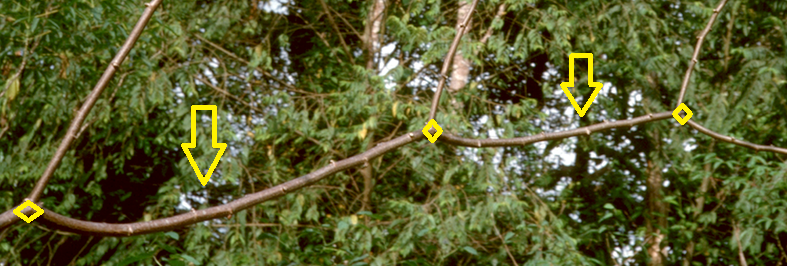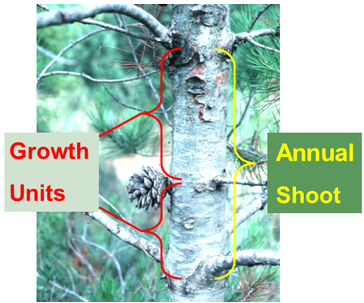Preliminary Course
Botany. Architectural Analysis
Plant organization
In many species the edification of an axis is due to a rhythmic process of growth.
The terminal or apical bud periodically breaks (in northern temperate countries in springtime) and new organs of the leafy stem are expanded.
This new stem portion thus elaborated during a continuous expansion phase is called a growth unit.
Growth units and annual shoot levels
-
As defined by Hallé and Martin (1968), a growth unit is the portion of stem expanded
during an uninterrupted phase of expansion.
The growth unit, in a plant structure, is a key notion for plant structure modelling and simulation.

Branch of Cassava.
Two successive growth units on a cassava branch. (Manihot esculenta, photo M. Jaeger, CIRAD)
In some temperate species, shoot expansion may occur in one, two or more successive events giving rise to an annual shoot made up of one or a succession of several growth units or growth cycles occurring in a growing season.
More generally, rhythmic growth can be expressed several times during a growing season: this is called polycyclism, while the appearance of a single growth unit is called monocyclism (Bugnon and Bugnon, 1951 or Lanner 1976)

An annual shoot on a young pine (Pinus halepensis).
This annual shoot (delimited in yellow) is a case of polycyclism, built from two growth units (delimited in red).
(Photo Y. Caraglio, CIRAD)
Bibliography
Hallé, F., Martin, R. 1968. Etude de la croissance rythmique chez Hevea brasiliensis Müll. Arg (Euphorbiaceae - Crotonoïdées). Adansonia, Série 2 8: 475-503.
Bugnon P., Bugnon F. 1951. Feuilles juvéniles et pousses multinodales chez le Pin maritime. Bulletin de la Société d'Histoire Naturelle de Toulouse, n. 86, p. 18-23.
Lanner R. M. 1976. Patterns of shoot development in Pinus and their relationship to growth potential. In Cannell, M. G. R., Last, F. T. (Eds). Tree physiology and yield improvement. London : Academic Press, p. 223-243 .
Definition
